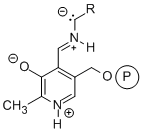Enzymes as Practical Catalysts for Organic Synthesis
Enzymes are intrinsically chiral catalysts since they are built from optically pure monomers (L-amino acids). This property makes them excellent starting points for developing methodology for stereoselective organic synthesis. In addition, enzymes are completely biodegradable and often work well in water, which are important properties when considering how chemical synthesis can be made more sustainable. Our past efforts have involved work on flavin-dependent Baeyer-Villiger monooxygenases, alcohol dehydrogenases and alkene reductases (also called ene-reductases or enoate reductases).
Pyridoxal-phosphate dependent enzymes. Pyridoxal phosphate (PLP) is a versatile cofactor involved in decarboxylations, transaminations, racemizations and C–C bond forming reactions.  All the reactions involve Schiff’s base formation between an amino group on the substrate and the cofactor, and this stabilizes an anion on the carbon adjacent to the amine. We are currently exploring several PLP-dependent enzymes in an effort to make them even more useful for chemical synthesis.
All the reactions involve Schiff’s base formation between an amino group on the substrate and the cofactor, and this stabilizes an anion on the carbon adjacent to the amine. We are currently exploring several PLP-dependent enzymes in an effort to make them even more useful for chemical synthesis.
Non-heme iron oxygenases. Carotenoid cleavage oxygenases (CCOs, also known as CCDs) perform the biochemical equivalent of ozonolysis. These enzymes contain one tightly bound Fe ion in the active site and require no additional cofactors. Because they do not use ozone, ![]() these enzymes are much more environmentally benign and avoid toxicity and safety concerns. Past experience has shown that these enzymes accept an array of carotenoids; our goal is to broaden the substrate specificity to include alkenes of synthetic interest and add these to the synthetic toolkit.
these enzymes are much more environmentally benign and avoid toxicity and safety concerns. Past experience has shown that these enzymes accept an array of carotenoids; our goal is to broaden the substrate specificity to include alkenes of synthetic interest and add these to the synthetic toolkit.
Alkene reductases. We still maintain an interest in alkene reductases, particularly those of the Old Yellow Enzyme (OYE) family. We have carried out extensive protein engineering and x-ray crystallographic studies of these enzymes to make them useful for organic synthesis.